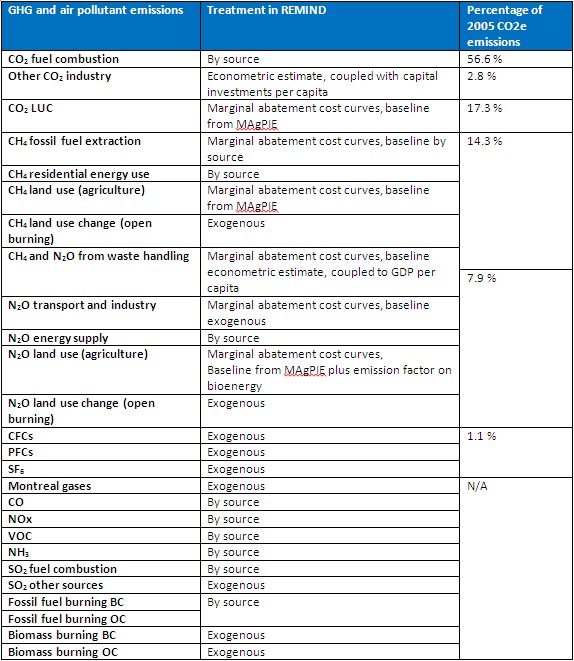GHGs - REMIND-MAgPIE: Difference between revisions
m (1 revision imported) |
m (Text replacement - "(Image:REMINDIMPORT\/attachments\/[0-9]*\/[0-9]*.jpg\|)" to "File:") |
||
| Line 11: | Line 11: | ||
Table 9. Overview of the treatment of GHG and air pollutant emissions | Table 9. Overview of the treatment of GHG and air pollutant emissions | ||
[[ | [[File:54067658.jpg]] | ||
Revision as of 12:46, 24 August 2016
| Corresponding documentation | |
|---|---|
| Previous versions | |
| Model information | |
| Model link | |
| Institution | Potsdam Institut für Klimafolgenforschung (PIK), Germany, https://www.pik-potsdam.de. |
| Solution concept | General equilibrium (closed economy)MAgPIE: partial equilibrium model of the agricultural sector; |
| Solution method | OptimizationMAgPIE: cost minimization; |
| Anticipation | |
REMIND simulates emissions from long-lived GHGs (CO2, CH4, N2O), short-lived GHGs (CO, NOx, VOC) and aerosols (SO2, BC, OC). REMIND accounts for these emissions with different levels of detail depending on the types and sources of emissions (see Table 9). It calculates CO2 emissions from fuel combustion, CH4 emissions from fossil fuel extraction and residential energy use and N2O emissions from energy supply based on sources. The energy system provides information on the regional consumption of fossil fuels and biomass for each time step and technology. For each fuel, region and technology, REMIND applies an emission factor to the specific gas in order to calculate the emissions.
CH4, N2O, and CO2 from land-use change have mitigation options that are independent of energy consumption. However, costs are associated with these emissions. Therefore, REMIND derives the mitigation options from marginal abatement cost (MAC) curves, which describe the percentage of abated emissions as a function of the costs. It is possible to obtain baseline emissions - to which the MAC curves are applied - by three different methods: by source (as described above), by an econometric estimate, or exogenously. REMIND uses the econometric estimate for CO2 emissions from cement production as well as CH4 and N2O emissions from waste handling. In both cases, the driver of emissions depends on the development of the GDP (as a proxy for waste production) or capital investment (as a proxy for cement production in infrastructure). REMIND uses exogenous baselines for N2O emissions from transport and industry.
Emissions of other GHGs (e.g. F-gases, Montreal gases) are exogenous and are taken from the RCP scenarios (Vuuren et al. 2011). There are no abatement options; therefore, emissions from the RCP scenario best matching the target of the specific model are used.
Table 9. Overview of the treatment of GHG and air pollutant emissions
